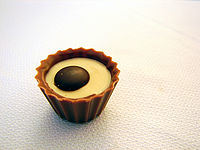Confectionery

Confectionery is the set of food items that are rich in sugar, any one or type of which is called a confection. Modern usage may include substances rich in artificial sweeteners as well. The word candy (U.S.), sweets (UK) or lolly (Australia) is also used for the extensive variety that compose confectionery. Generally speaking, confections are low in nutritional value but rich in calories. Specially formulated chocolate has been manufactured in the past for military use due to its high concentration of calories.
Contents |
Regional names
Different dialects of English use regional terms for confections:
- In Britain, Ireland and some Commonwealth countries, sweets or more colloquially sweeties (particularly used by children, sweeties also resembles the Scottish Gaelic word suiteis in pronunciation and meaning ). In some parts of England, spogs, spice, joy joy and goodies are terms used, alongside sweets, to denote confectionery. In North-West England, especially Lancashire, toffees is often used as a generic term for all confectionery. Northeast England and the Scottish Borders commonly use the word ket (plural kets) and more recently chud, derivative of chuddy, a localised term for chewing gum.
- In Australia and New Zealand, "lollies".
- In North America, "candy" - although this term can also refer to a specific range of confectionery and does not include some items called confectionery (e.g. pastry) (See below and the separate article on candy.) "Sweets" is occasionally used, as well as "treat"
Examples

Confectionery items include sweets, lollipops, candy bars, chocolate, candy floss, and other sweet items of snack food. The term does not generally apply to cakes, biscuits, or puddings which require cutlery to consume, although exceptions such as petit fours or meringues exist. Speakers of American English do not refer to these items as "candy". See candy making for the stages of sugar-cooking.
Some of the categories and types of confectionery include the following:
- Hard sweets: Based on sugars cooked to the hard-crack stage, including suckers (known as boiled sweets in British English), lollipops, jawbreakers (or gobstoppers), lemon drops, peppermint drops and disks, candy canes, rock candy, etc. These also include types often mixed with nuts such as brittle. Others contain flavorings including coffee such as Kopiko.
- Fudge: A confection of milk and sugar boiled to the soft-ball stage. In the US, it tends to be chocolate-flavored.
- Toffee (or Taffy or Tuffy): Based on sugars cooked to the soft-ball stage and then pulled to create an elastic texture. In British English, toffee can also refer to a harder substance also made from cooked sugars which resembles toffee.
- Tablet. A crumbly milk-based soft and hard candy, based on sugars cooked to the soft-ball stage. Comes in several forms, such as wafers and heart shapes.
- Liquorice: Containing extract of the liquorice root. Chewier and more resilient than gum/gelatin candies, but still designed for swallowing. For example, Liquorice allsorts. Has a similar taste to Star Anise.

- Chocolates are bite-sized confectioneries. People who create chocolates are called chocolatiers, and they create their confections with couverture chocolate. A chocolate maker, on the other hand, is the person who physically creates the couverture from cacao beans and other ingredients.
- Jelly candies: Including those based on sugar and starch, pectin, gum, or gelatin such as Lokum / Turkish Delight, jelly beans, gumdrops, jujubes, cola bottles gummies, etc.
- Marshmallow: "Peeps" (a trade name), circus peanuts, fluffy puff, etc.
- Marzipan: An almond-based confection, doughy in consistency, served in several different ways. It is often formed into shapes mimicking (for example) fruits or animals. Alternatively, marzipan may be flavoured, normally with spirits such as Kirsch or Rum, and divided into small bite-sized pieces; these flavoured marzipans are generally served coated in chocolate to prevent the alcohol from evaporating, and are very common in northern Europe. Marzipan is also used in cake decoration. Its lower-priced version is called Persipan.
- Divinity: A nougat-like confectionery based on egg whites with chopped nuts.
Not all confections equate to "candy" in the American English sense. Non-candy confections include:
- Dodol: A toffee-like food delicacy popular in Indonesia, Malaysia, and the Philippines
- Mithai: A generic term for confectionery in India, typically made from dairy products and/or some form of flour. Sugar or molases are used as sweeteners.
- Pastry: A baked confection whose dough is rich in butter, which was dispersed through the pastry prior to baking, resulting in a light, flaky texture; see also pie and tart.
- Chewing gum: Uniquely made to be chewed, not swallowed. However, some people believe that at least some types of chewing gum, such as certain bubble gums, are indeed candy.
- Ice cream: Frozen flavoured cream, often containing small chocolates and fruits
- Halvah: Confectionery based on tahini, a paste made from ground sesame seeds.
- Alfajor: a traditional South American cookie typically consisting of two round sweet biscuits joined together with a sweet jam, generally dulce de leche (milk jam).
- Dragée - Coated almonds and other types of coated candy.
Risks
Excessive consumption of confectionery has been associated with increased incidences of type 2 diabetes, obesity, and tooth decay.[1]
See also
- Dodol
- Jalebi (Type of Indian sweet)
- Confectionery store
- Confectionery Labels
References
- ↑ Magee, Elaine; "Sugar: What Kinds to Eat and When" WebMD.com (Health & Cooking), 28 January 2009 (Retrieved: 11 July 2009)
Further reading
- Richardson, Tim H. (2002). Sweets: A History of Candy. Bloomsbury USA. ISBN 1-58234-229-6.
- Stroud, Jon (2008). The Sucker's Guide - A Journey into the Soft Centre of the Sweet Shop. Summersdale. ISBN 9781840247091.
- Weatherley, Henry (1865). A Treatise on the Art of Boiling Sugar. http://books.google.com/books?id=lH4EAAAAYAAJ. Retrieved 2008-07-14.
- Kennedy, Angus (2008). Kennedy's Confection Magazine. http://www.kennedysconfection.com.
|
|||||||||||||||||||||||||||||